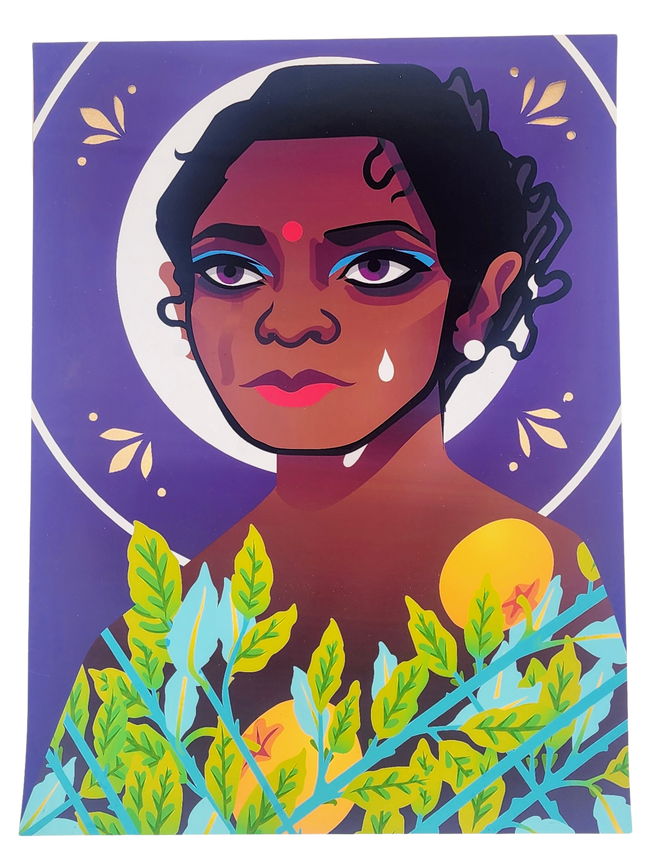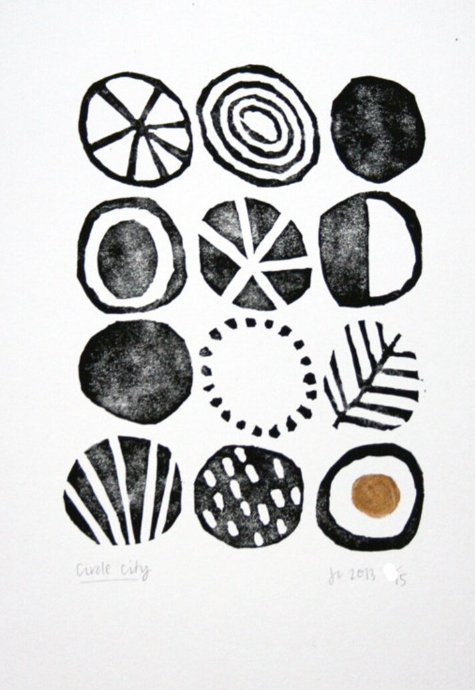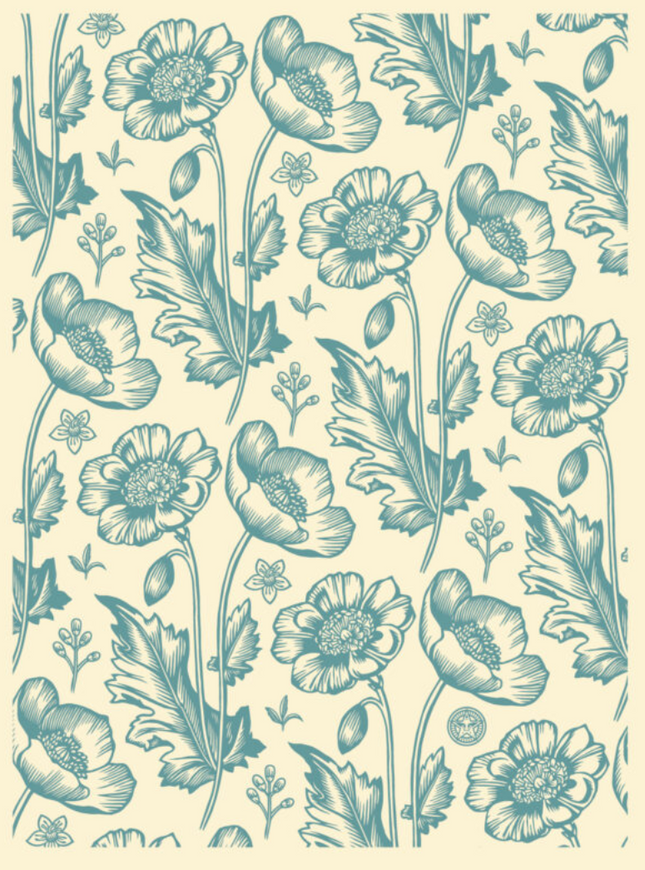
Flowers & Plants

Kevin Stanton Rita Gold Hand Cut HPM Giclee Print by Kevin Stanton
Rita Gold Hand Cut HPM Spray Paint Giclee Print by Kevin Stanton Artwork Limited Edition Print on Layered Glitter Fine Art Paper Hand Embellished Print Graffiti Pop Street Artist. 2013 Signed & Numbered Spray Paint Glitter Paper Hand Cut Embellished Limited Edition of 4 Artwork Size 11.75x15.75 HPM Giclee Print. Gold Paper Collage of THE Woman Amara Karan From India & Movie The Darjeeling Limited Stylized Look. Kevin Stanton's "Rita Gold": A Harmony of Tradition and Innovation Kevin Stanton's "Rita Gold" stands as a profound expression of creativity and cultural homage within the modern art scene, particularly within the genres of Street Pop Art and Graffiti Artwork. This piece is a hand-cut HPM (hand-painted multiple) Giclee print. This limited edition fuses traditional paper-cutting techniques with the contemporary flair of spray paint and the luxury of a gold paper collage. Released in 2013, "Rita Gold" is an exclusive series with only four signed and numbered prints. Each piece measures 11.75x15.75 inches and is presented on layered glitter fine art paper, further hand-embellished by the artist. The work reflects Stanton's intricate paper-cutting skills, a foundational aspect of his artistic journey that shapes his systematic approach to composition—prioritizing the form and silhouette before the detail of line. Capturing Cultural Essence Through Cut-Paper Artistry "Rita Gold" is a celebration of Indian aesthetics, depicted through the stylized portrayal of a woman whose gaze and posture exude a sense of contemplative serenity. Stanton's use of gold paper collage works with hand-embellishments to elevate the artwork, infusing it with a tactile depth that cannot be replicated by digital means alone. The contrast between the reflective gold elements and the matte textures of the spray-painted background creates a dynamic visual experience that draws the viewer into a deeper engagement with the piece. The artwork's layered composition is a nod to the complexity of Indian culture and its rich tapestry of symbols, colors, and historical references. Stanton's work delves into storytelling through visual cues, where each cut and hue is a deliberate choice meant to convey meaning and provoke thought. Blending Fine Art with Street Art Sensibilities Street pop art and graffiti artwork are often characterized by their public accessibility and vibrant immediacy, qualities that Kevin Stanton skillfully incorporates into "Rita Gold." By choosing to work on a small scale and with a limited edition series, Stanton bridges the typically vast and open-ended world of street art with the exclusivity and intimacy of fine art. This piece embodies the versatility and adaptability of street art influences when placed in the hands of an artist who respects the medium's history while pushing its boundaries. The hand-cut elements and spray paint application are reminiscent of the graffiti artist's stencil and can technique, yet the final product is more delicate and refined. Kevin Stanton: An Artist of Precision and Passion Kevin Stanton's commitment to his craft is evident in the meticulous execution and thoughtful presentation of "Rita Gold." His dedication to blending traditional art forms with modern techniques makes his work stand out in a crowded field of contemporary artists. The limited nature of this print series speaks to his artwork's exclusivity and bespoke quality, ensuring that each piece is not merely a visual spectacle but also a collector's item. Stanton's "Rita Gold" is more than a print; it is a testament to the power of art to transcend cultural barriers and to resonate with a universal audience. The print remains a captivating piece within Stanton's oeuvre, capturing the essence of street pop art and graffiti artwork through a unique lens that is both innovative and respectful of its diverse influences.
$150.00

Jen Collins Circle City HPM Lithograph Print by Jen Collins
Circle City HPM Lithograph Print by Jen Collins Hand Applied Gold Details Print on Recycled 280gsm A6 Card Stock Paper Limited Edition Pop Artwork. 2013 Signed & Numbered Limited Edition of 15 Artwork Size 5.8x8.3 Hand Applied Gold Paint
$104.00

Shepard Fairey- OBEY Cream & Blue Sedation in Bloom Silkscreen Print by Shepard Fairey- OBEY
Cream & Blue Sedation in Bloom Silkscreen Print by Shepard Fairey- OBEY Hand-Pulled on Cream Speckletone Fine Art Paper Limited Edition Artwork Obey Pop Culture Artist. 2021 Signed by Shepard Fairey- OBEY & Numbered Limited Edition of 150 Artwork Size 18x24 Sedation in Bloom Silkscreen Print Series. "I originally worked on this poppy pattern art as part of my collaboration with artist Gordon Cheung. In our piece, we addressed the tragic murder of Vincent Chin and the historical use of anti-Asian imagery and symbols in Western culture. The poppy is a beautiful flower with many symbolic interpretations, including peace, death, sleep, and sedation. I often weave floral and decorative patterns into my art to draw viewers in and make challenging concepts more digestible. However, decorative appeal can sedate people and distract them from more important social issues. Whether in entertainment, alcohol, drugs, or conspicuous consumption, I think sedation is a major cause of social and political complacency and ignorance. These Sedation In Bloom prints serve the dual purpose of a decorative escape and a reminder to stay awake and aware!" -Shepard Fairey- OBEY. Cream & Blue Sedation in Bloom: Reflecting on Society Through Street Pop Art The Cream & Blue Sedation in Bloom silkscreen print by Shepard Fairey, an iconic figure in the street pop art and graffiti artwork realm, stands as a thought-provoking piece that goes beyond mere aesthetic pleasure. Fairey, born as Frank Shepard Fairey on February 15, 1970, in Charleston, South Carolina, USA, has carved a niche for himself with works that often reflect a blend of political activism and artistry. This particular artwork, a part of the Sedation in Bloom series, is no exception. Hand-pulled on cream speckletone fine art paper, the Cream & Blue Sedation in Bloom is a limited edition artwork, with each piece signed and numbered by Fairey himself. The size of the artwork, 18x24 inches, offers a substantial canvas for the expression of intricate and symbolic imagery. Limited to an edition of 150, these prints capture the exclusive nature of Fairey's work. The Symbolism of Poppies in Fairey's Visual Language The motif of the poppy in this series carries rich symbolic interpretations, ranging from peace to death, and from sleep to sedation. Fairey's choice of the poppy is deliberate and multifaceted; it is not only about creating a pleasing visual but also about the underlying message it conveys. The interplay of the serene blue on cream reflects a tranquil aesthetic, yet the poppies' association with sedation challenges the viewer to look deeper into the societal implications of the artwork. Fairey’s work is a commentary on the complacency and ignorance that he perceives as pervasive in society. The seductive nature of entertainment, alcohol, drugs, and material excess serves as a means to sedate the masses, distracting them from social and political engagement. Through the Cream & Blue Sedation in Bloom print, Fairey juxtaposes the allure of the poppies with a call to consciousness, urging the viewer to stay awake and aware amid societal distractions. Artistic Collaboration and Social Commentary The inception of this poppy pattern art arose from Fairey's collaboration with Gordon Cheung, where the duo addressed the harrowing murder of Vincent Chin and the use of anti-Asian motifs in Western culture. By incorporating these themes into his street pop art, Fairey elevates the conversation from street-level discourse to a wider socio-political dialogue. The prints serve as a decorative escape, yet they double as a potent reminder of the importance of staying alert to the world's inequities and injustices. Shepard Fairey's Cream & Blue Sedation in Bloom is a striking example of how street pop art can be a powerful medium for social critique. As viewers engage with the harmonious color scheme and the delicate floral patterns, they are also confronted with the societal urge to remain vigilant. Through this series, Fairey reiterates his belief in the capacity of art to ignite change, to unsettle the comfortable, and to provoke a reawakening of social consciousness. The artwork symbolizes the dual role of art in modern culture: as an object of beauty and as a catalyst for awareness and action.
$600.00




